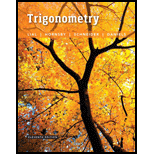
Hearing Difference Tones When a musical instrument creates a tone of 110 Hz, it also creates tones at 220. 330. 440. 550. 660, … Hz. A small speaker cannot reproduce the 110-Hz vibration but it can reproduce the higher frequencies, which are the upper harmonics. The low tones can still be heard because the speaker produces difference tones of the upper harmonics. The difference between consecutive frequencies is 110 Hz. and this difference tone will be heard by a listener. (Source: Benade. A., Fundamentals of Musical Acoustics. Dover Publications.)
(a) In the window [0.0.03] by [-1,1], graph the upper harmonics represented by the pressure
(b) Estimate all t-coordinates where P is maximum.
(c) What does a person hear in addition to the frequencies of 220. 330. and 440 Hz?
(d) Graph the pressure produced by a speaker that can vibrate at 110 Hz and above.
Want to see the full answer?
Check out a sample textbook solution
Chapter 6 Solutions
Trigonometry (11th Edition)
- skip A swimming pool plan has concrete stairs leading down into the shallow end How much concrete will be needed to build the stairs? Bift 9 ft 2 ft 1 ft 9 ft 2 ft 5 ft [ ? ] ft³arrow_forwardFor the given right triangle, the longer leg is 8 units long and the shorter leg is 6 units long. sina=arrow_forwardWrite the equation of the trigonometric function shown in the graph. LO 5 4 3 2 1 y -5 -5 4 8 8 500 -1 -2 -3 -4 -5 x 5 15л 5л 25л 15л 35π 5л 4 8 2 8 4 8arrow_forward
- 2. If log2 (sin x) + log₂ (cos x) = -2 and log2 (sin x + cos x) = (-2 + log2 n), find n.arrow_forwardIf cscx- cotx = -4, find cscx + cotx.arrow_forwardQuestion 10 (5 points) (07.04 MC) Vectors u and v are shown in the graph. -12-11 -10 -9 -8 -7 -6 -5 What is proju? a -6.5i - 4.55j b -5.2i+2.6j с -4.7631 3.334j d -3.81i+1.905j < + 10 6 5 4 3 2 -3 -2 -10 1 -1 -2 -3 u -4 -5 -6 -7arrow_forward
- Find the lengths of PR and OR in terms of the angles α and β. Find the angles ∠ONQ and ∠NPQ. Find the lengths of ON and PN in terms of the angle β. Find the length of PQ. Find the length of QR. Find the length of OM. Find the length of RM. What formula can you write down by noting that PR = QR + PQ? What formula can you write down by noting that OR = OM - RM?arrow_forward5) Solve the triangle. 2 95° 4 B с A) c=3.63, A=59.5°, B = 25.5° C) c = 4.63, A = 59.5°, B = 25.5° A B) c 4.63, A 25.5°, B = 59.5° = = D) c 5.63, A = 25.5°, B = 59.5°arrow_forwardFind zw. Leave your answer in polar form. = လ 3π 2 z = 6 cos 6 cos 37 3π + i sin 2 57 W = 12 cos + i sin 6 6 ༠།ལྦ་arrow_forward
- 10 Write the expression (1 – i) i)in the standard form a + bi.arrow_forward11) The letters r and 0 represent polar coordinates. Write the equation r sine = 10 using rectangular coordinates (x, y). A) x = 10y B) y = 10 C) x = 10 D) y = 10xarrow_forward18) Find all the complex cube roots of - 8i. Leave your answers in polar form with the argument in degrees.arrow_forward
- Algebra & Trigonometry with Analytic GeometryAlgebraISBN:9781133382119Author:SwokowskiPublisher:Cengage
 Trigonometry (MindTap Course List)TrigonometryISBN:9781305652224Author:Charles P. McKeague, Mark D. TurnerPublisher:Cengage Learning
Trigonometry (MindTap Course List)TrigonometryISBN:9781305652224Author:Charles P. McKeague, Mark D. TurnerPublisher:Cengage Learning

